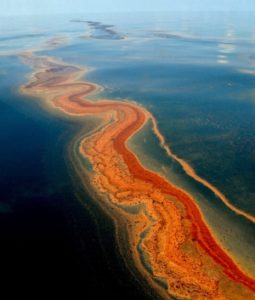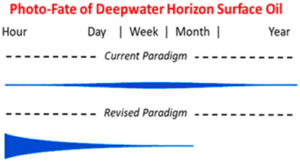Collin P. Ward, Charles M. Sharpless, David L. Valentine, Deborah P. French-McCay, Christoph Aeppli, Helen K. White, Ryan P. Rodgers, Kelsey M. Gosselin, Robert K. Nelson, and Christopher M. Reddy – Environmental Science & Technology 2018 52 (4), 1797-1805
Abstract
 Following the Deepwater Horizon (DWH) blowout in 2010, oil floated on the Gulf of Mexico for over 100 days. In the aftermath of the blowout, substantial accumulation of partially oxidized surface oil was reported, but the pathways that formed these oxidized residues are poorly constrained. Here we provide five quantitative lines of evidence demonstrating that oxidation by sunlight largely accounts for the partially oxidized surface oil. First, residence time on the sunlit sea surface, where photochemical reactions occur, was the strongest predictor of partial oxidation. Second, two-thirds of the partial oxidation from 2010 to 2016 occurred in less than 10 days on the sunlit sea surface, prior to coastal deposition. Third, multiple diagnostic biodegradation indices, including octadecane to phytane, suggest that partial oxidation of oil on the sunlit sea surface was largely driven by an abiotic process. Fourth, in the laboratory, the dominant photochemical oxidation pathway of DWH oil was partial oxidation to oxygenated residues rather than complete oxidation to CO2. Fifth, estimates of partial photo-oxidation calculated with photochemical rate modeling overlap with observed oxidation. We suggest that photo-oxidation of surface oil has fundamental implications for the response approach, damage assessment, and ecosystem restoration in the aftermath of an oil spill, and that oil fate models for the DWH spill should be modified to accurately reflect the role of sunlight.
Following the Deepwater Horizon (DWH) blowout in 2010, oil floated on the Gulf of Mexico for over 100 days. In the aftermath of the blowout, substantial accumulation of partially oxidized surface oil was reported, but the pathways that formed these oxidized residues are poorly constrained. Here we provide five quantitative lines of evidence demonstrating that oxidation by sunlight largely accounts for the partially oxidized surface oil. First, residence time on the sunlit sea surface, where photochemical reactions occur, was the strongest predictor of partial oxidation. Second, two-thirds of the partial oxidation from 2010 to 2016 occurred in less than 10 days on the sunlit sea surface, prior to coastal deposition. Third, multiple diagnostic biodegradation indices, including octadecane to phytane, suggest that partial oxidation of oil on the sunlit sea surface was largely driven by an abiotic process. Fourth, in the laboratory, the dominant photochemical oxidation pathway of DWH oil was partial oxidation to oxygenated residues rather than complete oxidation to CO2. Fifth, estimates of partial photo-oxidation calculated with photochemical rate modeling overlap with observed oxidation. We suggest that photo-oxidation of surface oil has fundamental implications for the response approach, damage assessment, and ecosystem restoration in the aftermath of an oil spill, and that oil fate models for the DWH spill should be modified to accurately reflect the role of sunlight.

… The three-hour dose of simulated sunlight, as measured by a NIST-calibrated spectroradiometer 215 (StellarNet Black Comet C-50), was equivalent to seven hours of natural UV irradiance to the 216 GoM from April 24 to 3 Aug 2010, the 102-day duration of the surface oiling …





